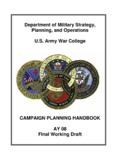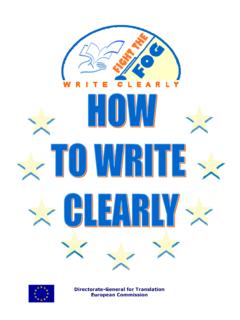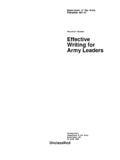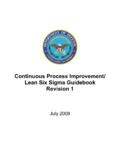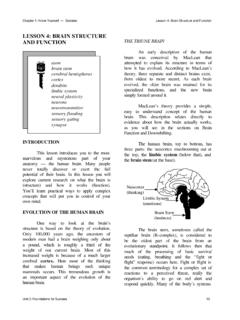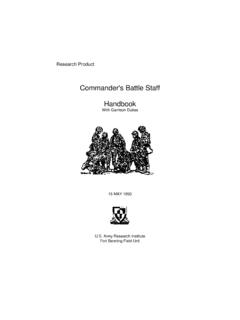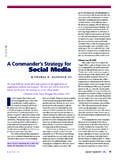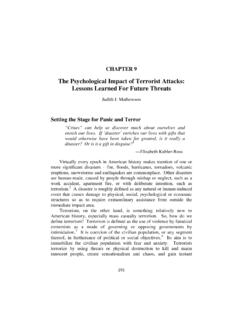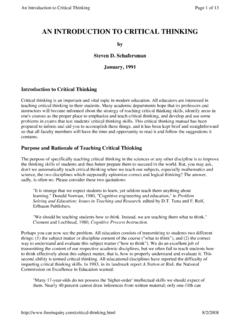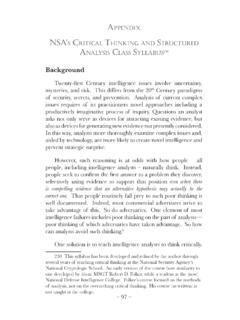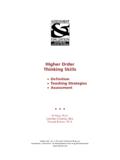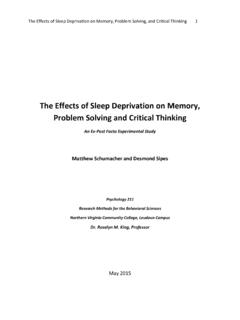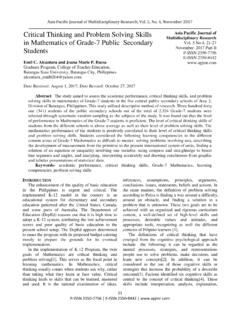Transcription of Leader Communication - Air University
1 CGSS STUDENT TEXT 22-2 Leader Communication COMMAND AND GENERAL STAFF SCHOOL ARMY COMMAND AND GENERAL STAFF COLLEGE FORT LEAVENWORTH, KANSAS June 2012 CGSS STUDENT TEXT 22-2 PREFACE leaders communicate effectively by clearly expressing ideas and actively listening to others. By understanding the nature and importance of Communication and practicing effective Communication techniques, leaders will relate to others and be able to translate goals into actions. Communication is essential to all other leadership competencies, Appendix A, FM 6-22. TRADOC Pam 525-8-2, The Army Learning Concept 2015, Appendix C, describes the most important 21st Century Soldier Competencies. Two of these important competencies are Communication and engagement (oral, written, and negotiation).
2 Soldiers and leaders express themselves clearly and succinctly in oral, written, and digital communications. They use interpersonal tact, influence, and Communication to build effective working relationships and social networks that facilitate knowledge acquisition and provide feedback necessary for continuous improvement. critical thinking and problem solving . Soldiers and leaders analyze and evaluate thinking , with a view to improving it. They solve complex problems by using experiences, training, education, critical questioning, convergent, critical , and creative thinking , and collaboration to develop situations. Throughout their careers, Soldiers and leaders continue to analyze information and hone thinking skills while handling problems of increasing complexity. Select leaders also develop strategic thinking skills necessary for assignments at the national level.
3 The Command and General Staff Officer Course (CGSOC) Intermediate Level Education (ILE) Common Core (CC) and Advanced Operations Course (AOC) require you to continue refining and strengthening your Communication skills while preparing for senior leadership responsibilities. One important skill is to think critically and creatively as you research and write papers or prepare and present briefings. The purpose of this student text is to Serve as a refresher on the basics of writing and speaking. Present a standard method for documenting sources. Identify a standard method for formatting documents. Provide standard references supporting effective writing and speaking. To meet these purposes Chapter 1 reviews the Army standard for writing, critical thinking , creative thinking , decision making, and problem solving .
4 Chapter 2 examines the writing standard including substance, organization, style, and correctness; the writing process; and the standard for documenting sources. CGSS STUDENT TEXT 22-2 Chapter 3 discusses academic ethics and the plagiarism policy of the Command and General Staff School. Chapter 4 addresses the elements of effective speaking. Chapter 5 reviews the responsibilities and duties of staff officers and staff coordination techniques. While providing an overview of the writing and speaking skills required of military leaders , this student text focuses on written and speaking evaluations during the Intermediate Level Education (ILE) Common Core, the Advanced Operations Course, and electives. We encourage everyone who reads this student text to recommend changes to keep the text current and helpful. Address your comments to Director of Academic Operations Command and General Staff School Army Command and General Staff College Lewis and Clark Center Room 3514 100 Stimson Ave Fort Leavenworth, KS 66027-1352 Our telephone number is: DSN 552-7314, or commercial (913) 684-7314.
5 CGSS STUDENT TEXT 22-2 Table of Contents Chapter 1 Paragraph Communication Skills for leaders Army Standard 1-2 Principles of Good Writing 1-3 critical thinking 1-12 Creative thinking 1-13 Decision Making 1-14 problem solving 1-15 Chapter 2 Writing Standard Substance 2-1 Organization 2-3 Style 2-4 Correctness 2-5 Writing Process 2-6 Research and Pre-Writing 2-7 Types of Essays 2-15 Planning and Organizing 2-23 Drafting 2-24 Essay Format 2-28 Revising and Editing 2-29 Example Bibliography and Note Format 2-35 Proofing and Final Product 2-36 Assessing Writing 2-37 Chapter 3 Academic Ethics Key Definitions 3-2 Copyright Laws 3-10 Academic Freedom 3-16 Non-Attribution Policy 3-18 Chapter 4 Military Briefings Characteristics 4-2 Types 4-3 Substance and Organization 4-5 Style and Correctness 4-14 CGSS STUDENT TEXT 22-2 Chapter 5 The Staff Officer Staff Characteristics 5-2 Staff's Role 5-13 Staff Actions 5-14 problem solving 5-18 Staff Coordination 5-19 Appendix Concise DMH Style Guide References Index CGSS STUDENT TEXT 22-2 CHAPTER 1 Communication SKILLS FOR leaders The liberty of speaking and writing guards our other liberties.
6 Thomas Jefferson 1-1. Mission accomplishment requires skilled leaders able to make the right decisions. Individuals who transmit their intent and ideas so that others understand the message and act on it possess one of the primary qualities of leadership--the ability to communicate effectively. Success as a military Leader depends on the ability to think critically and creatively and to communicate your intention and decision to others. How you arrive at your decision and communicate it to others is our focus. THE ARMY STANDARD FOR COMMUNICATIONS 1-2. The standard for Army writing is writing you can understand in a single rapid reading, and is generally free of errors in grammar, mechanics, and usage.
7 Good Army writing is concise, organized, and right to the point. Style rules include Put the recommendation, conclusion, or reason for writing the bottom line in the first or second paragraph, not at the end. Use the active voice. Use short sentences (an average of 15 or fewer words). Use short words (three syllables or fewer). Write paragraphs that, with few exceptions, are no more than 1 inch deep. Use correct spelling, grammar, and punctuation. Use I, you and we as subjects of sentences instead of this office, this headquarters, all individuals, and so forth, for most kinds of writing. Structure your writing to begin with the main idea first and transmit a focused message Open with a short, clear purpose sentence. Put the recommendation, conclusion, or most important information (the main point) next.
8 (Some writing combines the purpose and the main point). Clearly separate each major section. Use paragraphs, headings, or section titles. Use a specific format if one is appropriate. Style the active voice. The active voice is direct, natural, and forceful. The active voice does more than make sentences clearer it shortens sentences. Eliminating the passive voice reduces a piece of writing by about 20 percent. Active voice writing emphasizes the doer of the action, shows who or what does the action in the sentence, and creates shorter sentences. CGSS STUDENT TEXT 22-2 The passive voice is actually very easy to recognize: it uses one of the eight forms of to be plus a verb usually ending in en or ed. Example: am, is, are, was, were, be, being, been plus the en, ed word (is requested, were eaten). PRINCIPLES OF GOOD WRITING 1-3.
9 Army Regulation 25-50, Preparing and Managing Correspondence,* requires that writers incorporate the following principles into their communications Department of the Army, Army Regulation 25-50, Preparing and Managing Correspondence (Washington, DC: Government Printing Office, 3 June 2002) Online at Short, Sensible Sentences and Paragraphs 1-4. Effective writers employ both long and short sentences; however, the average sentence will be somewhere around 15 words.* The same holds true for paragraph length. Some paragraphs may be 2 inches in depth while others less than an inch, but the average paragraph will be about 1 inch (about 6 lines) deep for a single spaced document. Efficient Phrases, Vocabulary, and Images 1-5. Use commonly accepted words and word pictures. Know your audience. Avoid the use of jargon, "official-speak," and acronyms, especially when writing or speaking to an audience that may not be familiar with them.
10 SHORT, SENSIBLE SENTENCES AND PARAGRAPHS EFFICIENT PHRASES, VOCABULARY, AND IMAGES ACTIVE VOICE (PRIMARILY) PACKAGING THAT SUPPORTS SHORT, SENSIBLE SENTENCES AND PARAGRAPHS CGSS STUDENT TEXT 22-2 Active Voice (Primarily) 1-6. The topic of active or passive voice in writing and speaking seems to create a lot of confusion. The problem is that many writers confuse voice with tense and conclude that passive voice always refers to the past while active voice refers to the present or future. Voice only shows whether the subject is performing the action (active voice) or receiving the action (passive voice). Active and passive voice never refers to tense but to action. Key to determining active voice is to tell who is doing the acting. 1-7. You form the passive voice by using a form of the verb "to be" with the past participle of the main verb.
